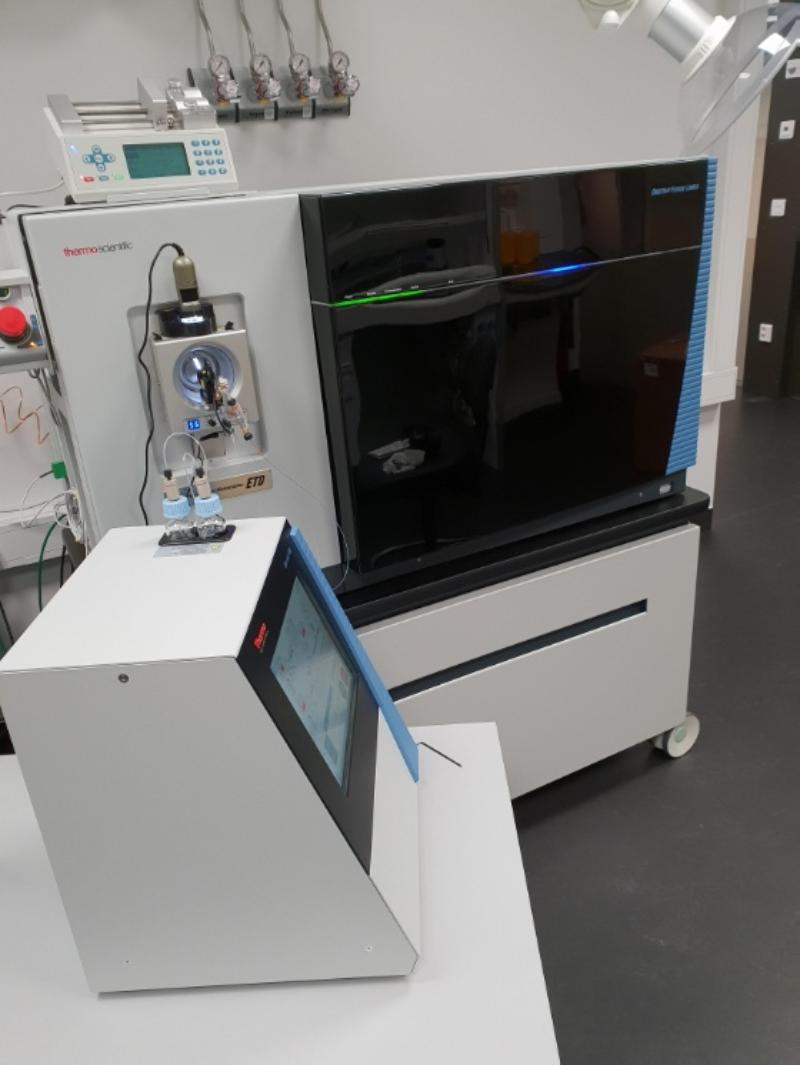
For targeted metabolomics we have Waters XEVO TQ-XS Triple Quadrupole mass spectrometer coupled to a Waters Acquity UPLC and and for untargeted metabolomics a Thermo Scientific Vanquish Horizon UHPLC coupled to a Thermo Scientific Orbitrap ID-X Tribrid Mass Spectrometer.
Additionally we have a Tecan pippetting robot.
Proteomics
Services:
- In-gel and in-solution protein digestion with sample cleanup
- Peptide labelling (TMT)
- Phosphopeptide enrichment
- Liquid chromatography-tandem mass spectrometry (LC-MS/MS) analysis of digested proteins
- Protein identification and quantitation
- Characterization of post translational modifications (PTM) in proteins
- Large-scale protein quantitation (SILAC, TMT, label-free)
Techniques:
In-gel and in-solution protein digestion:
To be able to analyse proteins, they need to digested into smaller peptides. This is typically done using trypsin, but also other proteases can be used for the digestion if needed. For in-gel digestion, proteins are digested with a protease in bands cut out from SDS-PAGE gels. Protein digestion can also be done in solution. To avoid problems with the LC-MS/MS analysis, the samples delivered in solution cannot contain certain chemicals like detergents Therefore, you should always contact us before delivering the samples in solution to our facility. We do sample cleanup with C18 pipet tips before the samples are injected into the LC-MS system.
Phosphopeptide enrichment:
With our LC-MS systems, it is possible to identify and quantify phosphorylations of proteins. To be able to detect as many phosphorylation sites as possible, we perform phosphopeptide enrichment by the use of TiO2 beads.
LC-MS/MS run:
Peptides from protein digestion are analysed by UHPLC-ESI-MS to be able to identify and quantify proteins. Peptides are first separated in a nanoLC, before sequential injection into an Orbitrap instrument (Q-Exactive) with high mass accuracy. Peptides are further fragmented in the MS by higher energy collisional dissociation (HCD) to facilitate protein identification. The mass spectra of the peptides and fragmented peptides are used for protein and PTM identification and their quantitation.

Data analysis:
Mass spectra are searched with Proteome Discoverer for protein and PTM identification and quantitation. For large scale protein quantitation, we use the MaxQuant software coupled with Perseus. We perform protein quantitation based on SILAC, stable isotope peptide labelling or label-free quantitation technologies. In SILAC experiments, proteins are labelled in vivo in cell culture by stable isotopes, typically by C13. For stable isotope peptide labelling, the peptides are labelled after protease digestion with the TMT isobaric mass tag. For label-free protein quantitation, no labelling is required. The quantitation is typically performed as either relative quantitation of proteins between different samples or absolute quantitation within a sample.
We offer services to users from both academia and private industry. We offer advices for the most appropriate design of proteomics experiments. It is therefore advisable to make contact with the platform BEFORE the start of the proteomic experiments to be able to find the best possible approach.
The users are requested to fill in a requisition form and deliver it together with the samples
PRICES (internal users):
| Sample preparation | ||
| Type of service | Unit | Price |
| In gel protein digestion | Per sample | 345 |
| In solution protein digestion | Per sample | 345 |
| TMT Labelling | On request | |
| Other analysis | On request | |
| Mass Spec analysis | ||
| Type of service | Unit | Price |
| Orbitrap Fusion Lumos LC-MS/MS and Protein identification | Hour | 950 |
| Orbitrap Exploris 480 and Protein identification | Hour | 675 |
| DeNovo Sequencing | On request | |
| SILAC analysis | On request | |
| Other analysis | On request |
For metabolomics services please contact us
External users: please contact us for pricing
You will find us at MH2 L10.303
Sideansvarlig: Bruun, Jack-Ansgar, Pitelkova, Iva